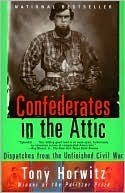More on this book
Community
Kindle Notes & Highlights
by
Tony Horwitz
Read between
November 16 - December 22, 2023
Faulk asked the students what came to mind when she said the words “Old South.” “Big Houses.” “Big dresses, too.” “Big parties, like in Gone With the Wind and North and South.” “Hard work, cotton, slaves,” a black student said. He was the only black to speak up during the class.
Faulk’s next class was world history, so I went to the school library to look at the textbooks she’d given me. “Like most people in the South, Alabamans held a strong belief in states’ rights. Alabama joined the secession movement and fought against the Union in the Civil War.” Those two lines were all the ninth-grade primer had to say on the subject.
Integration had also turned the Civil War into a minefield. “Suddenly, whatever I said was wrong,” Shambray said. Blacks accused her of soft-pedaling slavery while whites thought she was vilifying their ancestors. Shambray found herself dreading the subject.
Then, from about the mid-1970s to the mid-1980s, the atmosphere improved and Shambray learned to ease her students into the Civil War. “I’d preface the whole issue by saying that none of us here today were responsible for what happened. It’s history, and we need to discuss things in an open, intelligent fashion.” But like others I’d spoken to across the South, Shambray sensed a hardening of attitudes from about the mid-1980s onward. Both blacks and whites became contentious and less interested in facts.
Each year, she asked for a special report on an historical subject. “There’s always a white student now who wants to report on the Klan. I’ve had a few claim they’re members.” Blacks, meanwhile, seemed intent on tuning out the nineteenth century. “They feel like it’s someone else’s war, history that belongs to someone else,” she said, echoing what I’d heard in Selma.
The conversation had become free-flowing and I raised my hand. Why, I asked from my lonely perch in the middle aisle, were all the whites sitting on one side of the room and blacks on the other? “It’s just always been that way,” one of the whites said. A black student nodded. “When we were younger we were all friends,” she said. “You didn’t think about black and white. But you get older, you hear things on the news. You look around. You hear the little things people say. Things change. We’re still friends but it’s different.”
After the day’s last class, I asked Faulk about the school’s informal apartheid and the fact that white students seemed far more outspoken and self-assured than blacks. “We had an exchange student from Macedonia,” she said. “He told me, ‘You know, blacks are in the majority here but they’re afraid of you.’ He was right. Blacks have grown up with whites being dominant and they seem to tolerate it.” Like Ruby Shambray, Faulk was also bewildered by what she called “a blip of good ol’ boyism” in recent years. “Before, kids really wanted to get along and understand each other. Then the urge just
...more
At first, Gamble said, white parents who sent their kids to private academies “were people with money who didn’t want their kids sitting next to blacks.” But as public schools deteriorated, the academies began to attract middle-class families who simply wanted their kids to have a better chance. The academies cost $150 a month, straining budgets and deepening resentment of blacks, whom many whites blamed for the decline of public schools. “It’s a vicious cycle and the whole South is caught in it, the whole nation, really,” she said.


